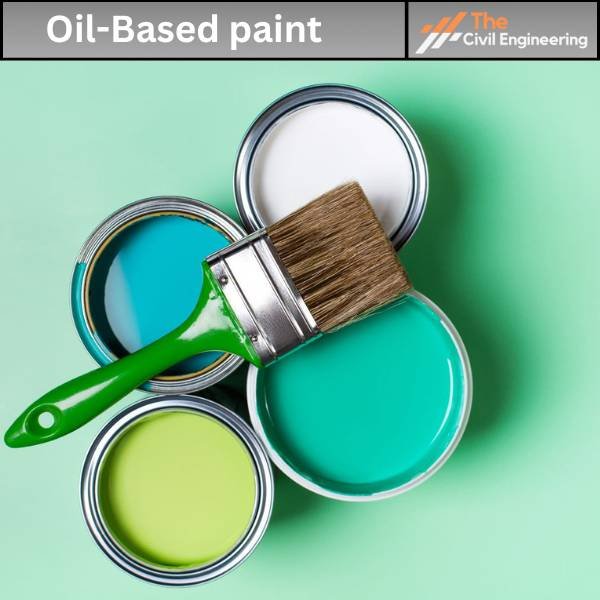In this article, we will discuss emulsion paint vs oil based paint.
1. Introduction
Paint is used as a protective covering to prevent corrosion, chemical attacks, and other weathering effects.
It is also used to enhance the aesthetic appearance of the structure.
All paints are not suitable for all conditions. For different conditions, different types of paints are desirable.

2. Characteristics of Good Paint
The characteristics of good paint can be listed as follows:
a. Paint should have high coverage and durability.
b. It must be able to form an elastic, tough, and hard film upon drying.
c. The paint must have a good hiding power and must impart the required colour.
d. It must not crack upon drying.
e. It must be able to resist the weathering effects as well as corrosion.
f. The paint must dry quickly.
g. The colour imparted by the paint should not fade away within a short period.
h. It must be resistive to blistering, cracking, and moisture.
i. The brush marks should not appear after application.
j. The paint must provide a long-lasting pleasing appearance.
3. Emulsion Paint
The emulsion paint is a mixture of two liquids that do not blend well with each other i.e. the mixture of two different non-blending liquids.
In the emulsion paint, 50 to 60% volume of water is present and the remaining portion consists of the oily or solid portion in the pigment form. The oily particles have a higher density than water.

| Read Also: Emulsion Paint |
4. Oil Based Paints
Oil-based paint is a type of paint that consists of pigments suspended in the drying oil commonly linseed oil. Oil-based paints need naphtha, turpentine and white spirit as a thinner. It is less expensive than Emulsion paints.

5. Emulsion Paint Vs Oil Based Paints
The differentiation chart between the Emulsion Paint and Oil-based paints.
| S.N. | Emulsion Paint |
Oil Based Paint |
| 1 | Emulsion paints are water-based paints with various permanent substances like Alkyd resins, acrylic resin and epoxy as a binder. | Oil-based paint is a type of paint that consists of pigments suspended in the drying oil commonly linseed oil. |
| 2 | There is no need for thinner emulsion paints. | Oil-based paints required naphtha, turpentine and white spirit as a thinner. |
| 3 | Emulsion paints are more durable and do not crack. | Oil-based paints are less durable as compared to emulsion paint and turn yellow with time and may crack. |
| 4 | In the Emulsion paints water is used as a solvent. | Oil-based paints do not require a solvent. |
| 5 | Emulsion paints have a slight smell. | Oil-based paints have a strong smell. |
|
6 |
Alkyd resins, acrylic resin and epoxy are used as a binder in the Emulsion paints. | Linseed oil, tung oil, poppy oil and nut oil are used as a binder in oil-based paints. |
| 7 | Emulsion paints dry quickly. | Oil-based paints take time to dry. |
| 8 | The washability of the emulsion paints is excellent and they can be washed with the help of water. | The washability of the oil-based paint is not so well and it cannot be washed with the use of water. |
| 9 | The hardness of the emulsion paints is high. | The hardness of the oil-based paints is less as compared to the emulsion paints. |
| 10 | One litre of emulsion paint can cover 100-160 square feet of area for two coats. | One litre of oil-based paints can cover 100-130 square feet area for two coats. |
| 11 | Emulsion Paints are flexible and do not crack due to the change in temperature. | The oil-based paints are not flexible and can crack due to the change in temperature. |
|
12 |
Emulsion Paints are Inflammable. | Oil-based paint is flammable. |
| 13 | Emulsion Paints are completely safe for human and does not cause any harm. | Oil-based Paints consist of toxic substances which cause damage to the eyes and skin. |
| 14 | The emulsion Paints can be utilized on both exteriors as well as interior areas. | Oil-based paints are utilized for internal areas. |
| 15 | The emulsion paints are available in packs of 1 litre, 4 litres, 10 litres and 20 litres. | The Oil-based paints are available in the pack of 500ml,1 litre,4 litres, 10 litres and 20 litres. |
| 16 | It is more expensive than oil-based paints. | It is less expensive than Emulsion paints. |
6. FAQ
a. What is emulsion paint used for?
Emulsion mostly refers to paint used for walls and ceilings. It’s water-based with vinyl or acrylic added for durability.
b. Is emulsion paint washable?
The washability of the emulsion paints is excellent and they can be washed with the help of water.
| Read Also: Difference Between Cement and Lime Plaster |

